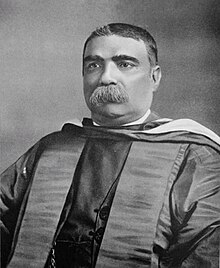Ashutosh Mukherjee | |
|---|---|
 Ashutosh Mukherjee | |
| 22nd, 26th Vice Chancellor of Calcutta University | |
| In office 4 April 1921 – 3 April 1923 | |
| Preceded by | Nilratan Sircar |
| Succeeded by | Bhupendranath Basu |
| In office 31 March 1906 – 30 March 1914 | |
| Preceded by | Alexander Pedler |
| Succeeded by | Devaprasad Sarvadhikary |
| Personal details | |
| Born | 29 June 1864 Calcutta, Bengal, British India (now West Bengal, India) |
| Died | 25 May 1924 (aged 59) Patna, Bihar and Orissa, British India (now Bihar, India) |
| Resting place | Russa Road, Calcutta (Now 77 Ashutosh Mookerjee Road, Kolkata – 700025) |
| Citizenship | British |
| Spouse | Jogomaya Devi |
| Children | 4, including Syama Prasad Mukherjee |
| Relatives | Chittatosh Mookerjee (grandson) |
| Education | University of Calcutta (BA, MA, MSc, LLD) |
| Occupation | Educator and the second Indian Vice-Chancellor of the University of Calcutta Judge of the Calcutta High Court (1903–1924) |
| Awards | Knight Bachelor (1911) Companion of the Order of the Star of India (CSI, 1909) |
Sir Ashutosh Mukherjee CSI FRAS FRSE MRIA[1][2] (anglicised, originally Asutosh Mukhopadhyay,[2] also anglicised to Asutosh Mookerjee) (29 June 1864 – 25 May 1924) was a Bengali mathematician, physicist, lawyer, jurist, judge, educator, and institution builder. A unique figure in Indian history, he made major contributions in three fields - mathematics, law, and higher education.
A holder of Masters degrees in both Mathematics and Natural Sciences, he was one of the first Indians to publish research papers in British journals. He became a Fellow of the Royal Society of Edinburgh at the age of 22, and was a Fellow or Member of various learned bodies in Europe and the United States.
Mukherjee passed his law examination and built a successful law practice. He received an LL.D. and gave lectures on law at the university. He became a judge of the Calcutta High Court, and acted as a Chief Justice for couple of years. He established the University College of Law at the university.
As the Vice-Chancellor of the University of Calcutta (1906–1914 and 1921–23), Mukherjee transformed an examination conducting, degree granting body into one of Asia's top research universities. He started new departments for post graduate study in various disciplines, raised funds to create new chaired professorships and build facilities, hired outstanding professors in diverse fields of study (including Asia's first Nobel Prize winning scientist Sir C.V. Raman), and supported graduated students in their efforts to pursue advanced research.
Mukherjee was the president of the inaugural session of the Indian Science Congress (1914). He played a major role in the foundation of the Bengal Technical Institute (1906), which later became Jadavpur University. He founded the Calcutta Mathematical Society (1908).[3] The Ashutosh College was also founded under his stewardship in 1916.
He is often called "Banglar Bagh" ('The Bengal Tiger') for his high self-esteem, courage and academic integrity.[4] According to historian D. R. Bhandarkar, the epithet 'Vikramaditya' is also ascribed to Sir Ashutosh Mukherjee.[5]
- ^ Cite error: The named reference
Mukhopadhyay_legacywas invoked but never defined (see the help page). - ^ a b "The mathematician in Asutosh Mukhopadhyay" (PDF). Current Science. Retrieved 29 September 2017.
- ^ Patrick Petitjean, Catherine Jami and Anne Marie Moulin eds. (1992) Science and Empires, Boston Study in the Philosophy of Science, Vol. 136, Kluwer Academic Publishers. ISBN 978-94-011-2594-9, doi:10.1007/978-94-011-2594-9
- ^ "Asutosh Mukhopadhyay: An eminent educator who made Bengalis proud".
- ^ Dutta, Ashis (29 June 2013). "First in class". The Hindu.